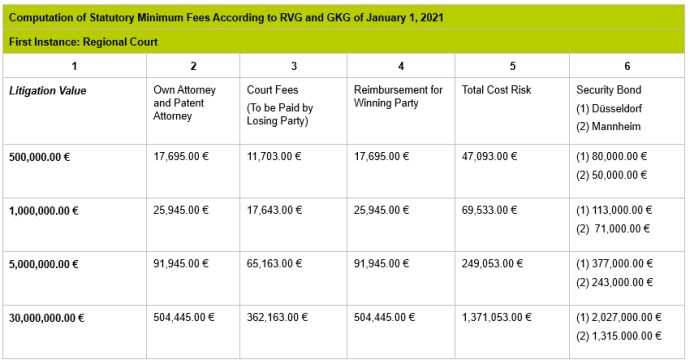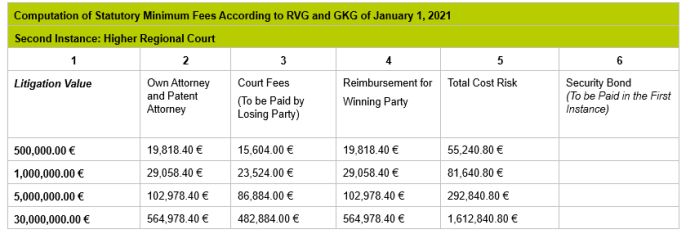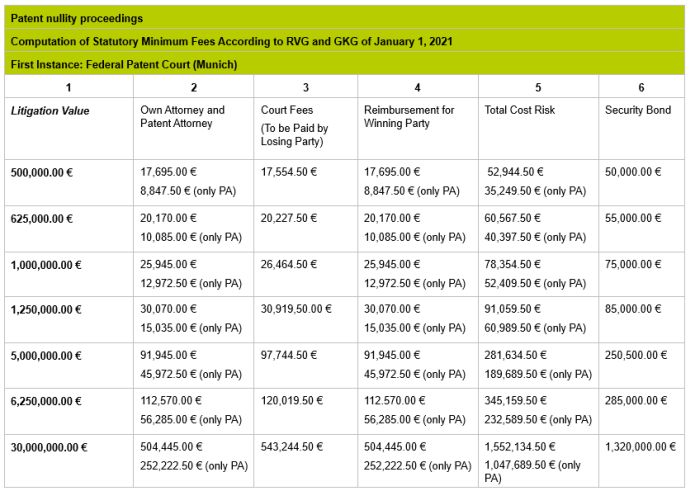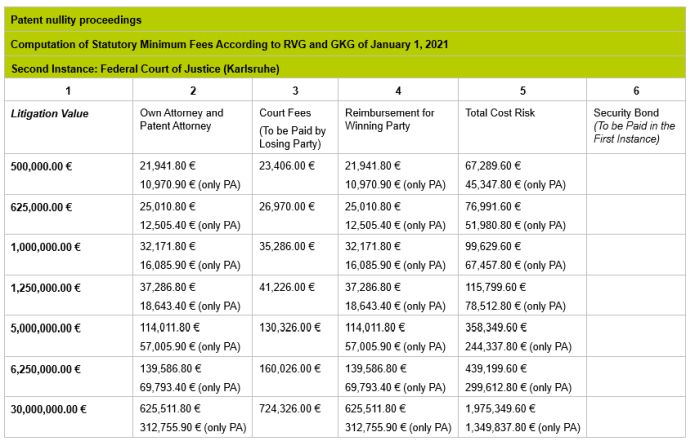Since the beginning of 2021, a new cost regime regarding the legal fees for lawyers and courts applies in Germany. Roughly estimated, this will lead to a fee increase of 10 %. This article provides an overview.
Cost issues in patent infringement and patent nullity proceedings
Unlike many other foreign legal systems, Germany has a costs regime that is guided by the principle that the losing party in a legal dispute should bear the costs of the legal dispute. As a consequence, the losing party must pay both court costs and opposing attorneys' fees. There is a legal framework for this with tables that show how much these costs to be paid by the losing party are in detail. If the party has not reached a different agreement with its own attorney and/or patent attorney, these statutory rules may also determine which fee is to be paid to these own attorneys / patent attorneys - irrespective of the outcome of the proceedings.
This legal framework does not only affect attorneys' fees to be paid or costs to be reimbursed but determines several other factors. For example, the claimant must advance court fees before the commencement of proceedings and ensure that the action is served on the defendant in the first place.
There is an important parameter for the amount of all these fees addressed, namely the "litigation value", which is also called the "object value". The litigation value, which the claimant states as a unilateral estimate in the statement of claim and which is determined by the court during the proceedings, indicates the economic significance of the claimant's claims.
To avoid misunderstandings and to answer a frequently asked question: the litigation value to be stated by the claimant and determined by the court is a very rough estimate that only has an impact on the cost issues. For example, the litigation value says nothing about the amount of damages the claimant can claim from the defendant after a successful patent infringement case or the actual value of a patent that is the subject of patent nullity proceedings.
Another important preliminary remark: In Germany, patent infringement proceedings and patent nullity proceedings are separate. The court entrusted with the patent infringement cannot decide on the invalidity of the patent but can - at most - stay the infringement proceedings if parallel patent nullity proceedings are pending. This often leads to parallel proceedings concerning patent infringement on the one hand and patent nullity on the other.


The two tables below provide an initial overview of the costs to be expected in first instance and second instance patent infringement proceedings. For the third instance, i.e. the non-admission appeal and/or the appeal proceedings before the Federal Court of Justice, a table has been omitted because there is too wide a range of cost-relevant possibilities for this.


Explanation of the tables:
The most important remark first: The tables do not represent the cost risk conclusively. They only give a rough overview of which costs the losing party has to reimburse to the winning party, which fees have to be advanced by the claimant at the beginning of the case or which security bond has to be provided by the claimant. The costs actually to be borne by a party may be higher for several reasons, for example because it has reached a fee agreement with its attorneys. In addition, the tables do not take into account various items regularly to be reimbursed by the losing party, such as: travel costs, costs for prior art searches, translation costs and, in rare cases, expert costs.
How are the tables to be understood?
- The first column shows typical litigation values as they are often set by the courts in patent infringement and patent nullity proceedings. The highest value is EUR 30 million, because this is the legal upper limit in this system. This value is only set in rare, economically very significant cases. Of course, in such cases the economic interest may have an even higher value, but this does not change the fact that the statutory fees based on this value reach their upper limit.
In the not uncommon cases where the patent owner has filed a patent infringement action and the alleged infringer has filed a patent nullity action in his defence, the Federal Patent Court hearing the patent nullity action in the first instance will initially base its decision on the litigation value set by the court hearing the patent infringement proceedings. If the Federal Patent Court has no other indications justifying a higher litigation value, it increases the litigation value set by the infringement court by 25 %.
- The second column lists the fees payable to one's own attorney and patent attorney for the respective instance. If there is a fee agreement, they may also be higher. In patent infringement proceedings, the case is usually handled by an attorney and a collaborating patent attorney. In patent nullity proceedings it is different: the process is usually handled by a patent attorney who is usually only assisted by an attorney if patent infringement proceedings are also pending.
- The third column lists the court fees to be advanced by the claimant at the beginning of the proceedings. The full payment of the court fees is important because otherwise the action will not even be served on the defendant. The question of whether the claimant or the defendant must advance the respective court fees in the further instances depends on the judgement of the previous instance.
For example, if a defendant in a patent infringement case is convicted in the first instance, he must advance the court fees in the appeal proceedings, i.e. the second instance.
- The fourth column lists the fees that a losing party must reimburse to the opposing party for its attorney and patent attorney for the respective instance. In patent infringement proceedings, these are regularly the fees for an attorney and a cooperating patent attorney.
A differentiation must be made for patent nullity proceedings:
If parallel patent infringement proceedings are pending, the fees for a patent attorney and a collaborating attorney are regularly recoverable. If the patent nullity action is brought without there being parallel patent infringement proceedings, only the fees for either the patent attorney or an attorney-at-law, but not for both, are recoverable as a rule.
- The fifth column shows the cost risk for the respective instance. The amount is made up of the individual amounts in columns 2, 3 and 4. These are the minimum costs to be borne by the unsuccessful party.
- The sixth column lists the amounts that in certain cases must be paid by the claimant as security at the beginning of the proceedings.
This so-called "security bond" is intended to cover the risk of the sued party actually being reimbursed its costs in the event of a successful outcome. It does not have to be provided if the claimant has his or her ordinary residence in a member state of the European Union or a state party on the Agreement on the European Economic Area.
For all other claimants, it must be examined whether, exceptionally, security bond does not have to be provided on the basis of international treaties. To give a prominent example: An American claimant must provide security bond.
The important first instance courts for patent infringement proceedings in Germany, namely Düsseldorf and Mannheim, calculate the amount of the security bond differently. The amounts concerned are shown in the sixth column with (1) for the Düsseldorf Regional Court and with (2) for the Mannheim Regional Court.
The Federal Patent Court applies a different calculation in patent nullity proceedings. The corresponding amounts for this court are also listed in the sixth column. If it turns out during the proceedings that the defendant would have a higher claim to reimbursement of costs if it were to prevail, the court may also increase the security bond to be provided.
The security bond is regularly provided in the form of a bank guarantee to be handed over to the defendant. If the claimant wins the case, the defendant must return the bank guarantee.
In summary, the cost risk for patent infringement and patent nullity proceedings in Germany is relatively low compared to other jurisdictions. In the USA in particular, considerably higher costs must be expected.
However, unlike in many other jurisdictions, there is a procedural principle that the losing party must bear the costs of the proceedings, i.e. opposing attorneys' and patent attorney's fees as well as court costs.
The content of this article is intended to provide a general guide to the subject matter. Specialist advice should be sought about your specific circumstances.

